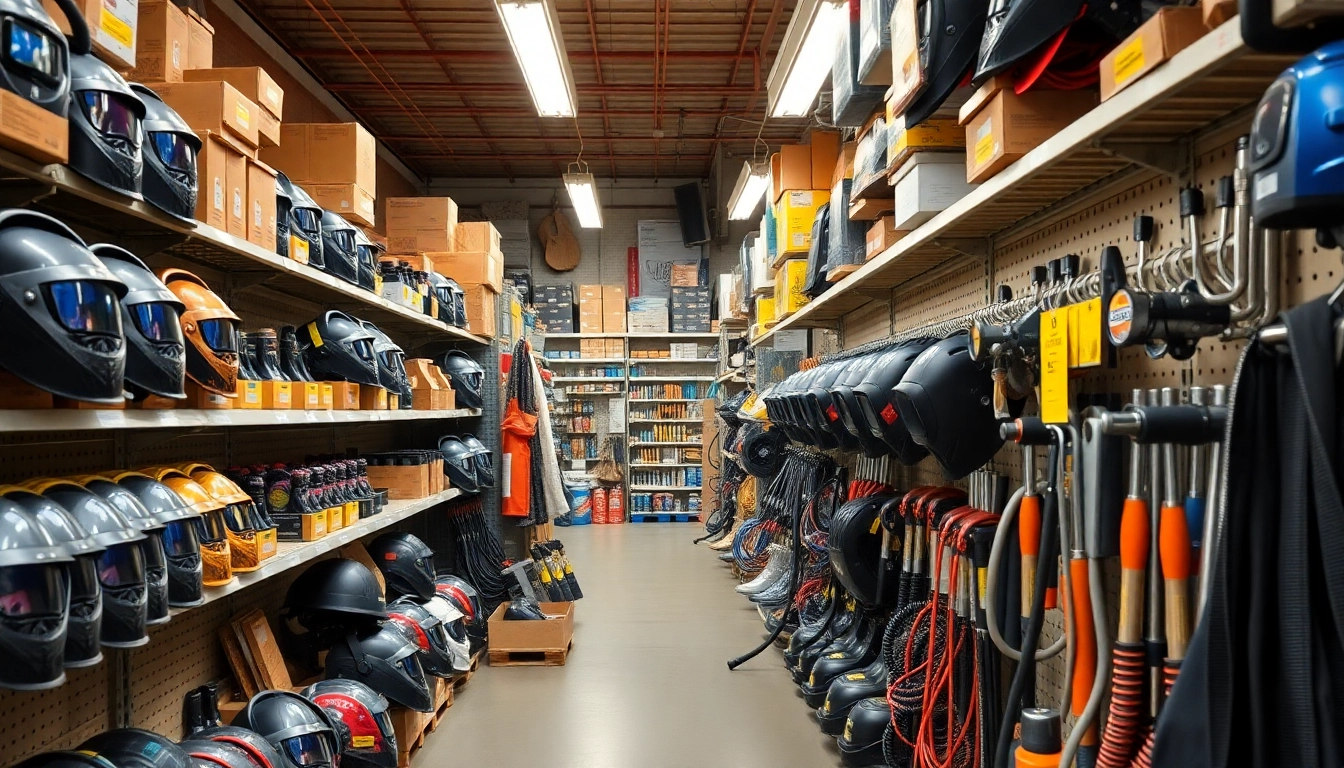Understanding Welding Supplies and Their Types
1. Introduction to Welding Supplies
Welding is an essential process in various industries, from construction to automotive and beyond. The success of any welding operation relies heavily on the quality and appropriateness of the welding supplies used. Welding supplies encompass a wide array of equipment, tools, and materials designed specifically for joining metal parts together through the application of heat and pressure. Understanding what these supplies are and how they function is crucial for both novice welders and seasoned professionals.
2. Types of Welding Equipment
Welding equipment can be classified into several categories based on the welding processes they support. Here are the main types:
- MIG Welders (Metal Inert Gas): These machines use a continuously fed wire electrode and an inert gas to shield the weld area. They are known for their ease of use, making them ideal for beginners.
- TIG Welders (Tungsten Inert Gas): This process involves a non-consumable tungsten electrode and requires more skill than MIG welding. TIG is favored for its precision, especially in thin materials.
- Stick Welders: Utilized for heavy-duty applications, stick welding uses a consumable electrode coated in flux to produce the weld. It is versatile and able to work in various positions.
- Plasma Cutters: While primarily used for cutting metal, plasma cutters are often essential in fabrication shops where precise cuts are required.
- Multi-Process Welders: These versatile machines combine multiple welding technologies into one unit, allowing the user to switch between types depending on the project demands.
3. Essential Welding Accessories
In addition to the primary welding machines, a variety of accessories enhance welding efficiency and safety:
- Welding Helmets: Essential for protecting the eyes and face from harmful radiation and sparks.
- Protective Clothing: Flame-resistant jackets and gloves are fundamental to safeguarding welders from burns and other injuries.
- Welding Blankets: These blankets protect surrounding materials from sparks and heat.
- Welding Clamps and Magnets: Tools that assist in holding workpieces in place during welding.
- Cleaning Tools: Chipping hammers, wire brushes, and grinders are necessary for ensuring clean welds and surface preparation.
Choosing the Right Welding Supplies for Your Needs
1. Factors to Consider When Selecting Supplies
When it comes to choosing welding supplies, several factors play a crucial role:
- Material Type: The type of metal being welded, whether steel, aluminum, or copper, will influence the choice of welding process and equipment.
- Welding Position: Understanding whether the welding will be done flat, vertical, or overhead helps determine the right supplies.
- Project Size: For large-scale industrial projects, robust and heavy-duty equipment is essential, whereas lighter, more portable tools may suffice for small repairs.
- Welding Environment: Outdoor work may require equipment that is weather-resistant, while indoor settings might allow for different choices.
2. Comparing Different Brands of Welding Equipment
With numerous brands offering welding supplies, it’s vital to know how they stack up against each other. Key brands include Miller, Lincoln Electric, and ESAB. Each brand provides unique features, warranties, and customer support options. Before making a purchase, consider aspects like:
- Performance: Review performance metrics from other customers and expert reviews.
- Service and Support: Evaluate the availability of service centers and support policy.
- Warranty: A robust warranty can signify a company’s confidence in its products.
3. Best Practices for Purchasing Welding Supplies
When equipping yourself with welding supplies, keep the following best practices in mind:
- Research: Always read reviews and seek feedback from other welders regarding their experiences with specific supplies.
- Buy from Reputable Suppliers: Ensure you’re purchasing from well-known suppliers who offer quality products and customer service.
- Try Before You Buy: If possible, testing equipment in-store allows you to know if it meets your comfort and performance standards.
Care and Maintenance of Welding Supplies
1. Maintaining Quality and Longevity of Equipment
Proper maintenance of welding supplies is essential for both performance and safety. Consider these maintenance routines:
- Regular Inspection: Inspect your welding machine and accessories frequently for wear and tear.
- Routine Cleaning: Clean equipment after each use to remove spatter, slag, and debris, which can affect performance.
- Lubrication: Ensure that moving parts are adequately lubricated to avoid friction and overheating.
2. Cleaning and Storage Tips for Welding Accessories
Cleaning and properly storing welding accessories prolong their life and effectiveness. Follow these guidelines:
- Store in a Dry Place: Ensure all tools are stored in a dry environment to prevent rust.
- Utilize Protective Cases: Use cases for tools such as helmets and gloves to prevent scratches and dirt accumulation.
- Labeling: Label shelves or boxes for easy identification of equipment, helping to streamline projects.
3. Troubleshooting Common Issues with Supplies
Common issues arise with welding equipment, and knowing how to address them can save time and money. Here are some troubleshooting tips:
- Arc Won’t Start: Check power connections, ensure gas flow, and examine electrode conditions.
- Inconsistent Bead Quality: Adjust your settings to ensure proper voltage and wire feed speed, and review your technique.
- Overheating: Ensure proper ventilation and rest your machine regularly during use to prevent overheating.
Safety Gear: A Crucial Component of Welding Supplies
1. Essential Personal Protective Equipment (PPE)
Personal protective equipment is vital in welding to prevent injuries caused by the high temperatures and flying sparks associated with the process. Essential PPE includes:
- Welding Helmets: Protects the eyes and face from UV radiation, sparks, and molten metal.
- Gloves: Heavy-duty gloves protect the hands from heat, cuts, and abrasions.
- Foot Protection: Steel-toed boots shield against heavy items falling and provide slip resistance.
- Respirators: Useful for protecting against toxic fumes, especially in confined spaces.
- Hearing Protection: Earplugs or earmuffs are essential in noisy environments to safeguard hearing.
2. Understanding Safety Standards in Welding
Every welding operation should adhere to established safety standards. Relevant standards may include:
- OSHA Regulations: The Occupational Safety and Health Administration outlines safety protocols for workplaces, including welding areas.
- ANSI Standards: The American National Standards Institute provides safety measures for various welding processes and PPE.
- NIOSH Guidelines: The National Institute for Occupational Safety and Health offers recommendations on reducing exposure to harmful substances during welding.
3. Compliance and Best Practices for Safety Gear
Ensuring compliance with safety regulations involves regular training and equipment checks:
- Training Sessions: Provide ongoing training for all workers on the use of PPE and safe welding practices.
- Regular Inspections: Conduct frequent inspections of PPE to ensure they are in good condition and replace any damaged gear.
- Promote a Safety Culture: Foster an environment where safety concerns can be openly discussed, and adherence to safety practices is encouraged.
The Future of Welding Supplies: Trends and Innovations
1. Advances in Welding Technology
The welding industry is continuously evolving with technological advancements that are enhancing efficiency and safety. Notable trends include:
- Robotic Welding: Automation is increasingly being used in welding processes, leading to higher precision and productivity.
- 3D Printing: Some welding techniques are being adapted for 3D printing applications, allowing for innovative designs and custom parts.
- Digital Welding Machines: Smart machines equipped with sensors and software provide real-time monitoring and adjustments for optimal performance.
2. Eco-Friendly Welding Supplies
As industries focus more on sustainability, there is a growing demand for eco-friendly welding products:
- Low-Emission Welding Gases: Suppliers are developing gases that produce fewer emissions and pollutants.
- Recyclable Materials: Innovations in welding consumables, like electrodes and wires, are leading to more recyclable options.
- Energy-Efficient Machines: Newer models of welders consume less energy while maintaining high performance.
3. Future Predictions for the Welding Industry
The next decade promises to bring even more changes to the welding landscape. Experts predict:
- Increased Demand for Skilled Labor: As technology progresses, so does the need for skilled operators who can handle advanced equipment.
- Expansion of Remote Work Capabilities: Technologies facilitating remote monitoring and control of welding processes will become more prevalent.
- Global Standards Harmonization: There will be a push for harmonizing welding standards across countries to ensure consistent safety and quality.













Leave a Reply